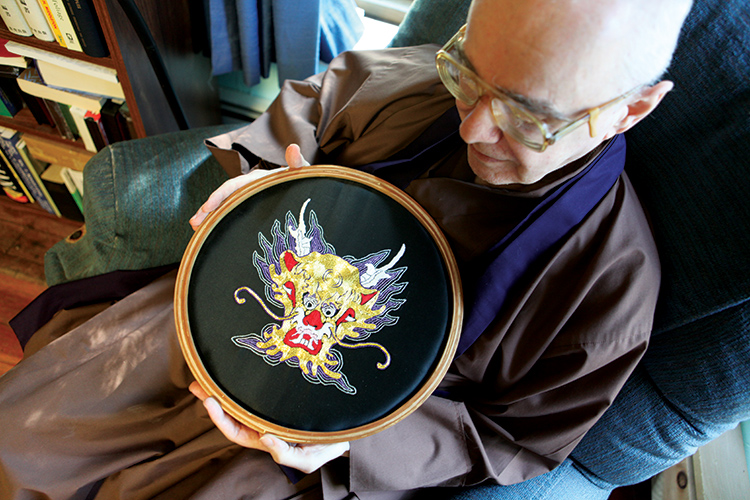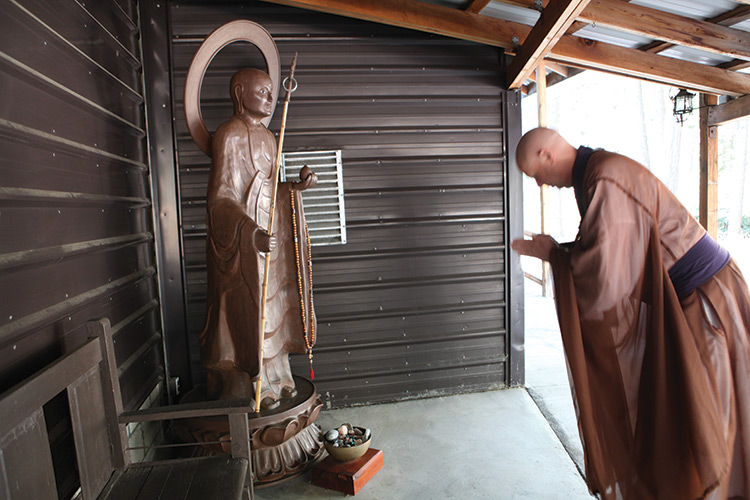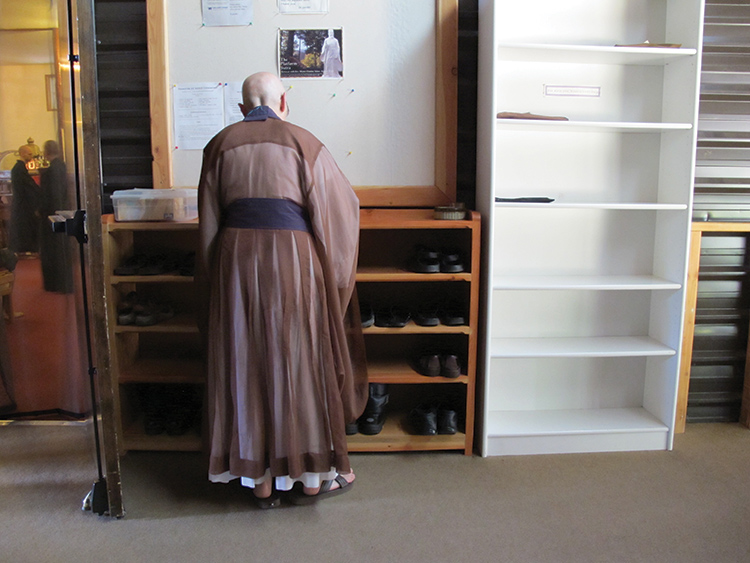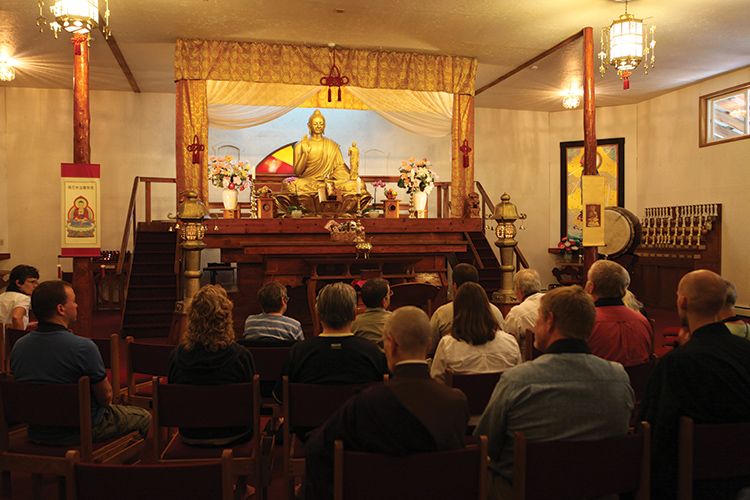A spring day at Shasta Abbey begins near dawn with the sound of bells. Buddhist monks walk down covered pathways past the hodgepodge of stone buildings that was once a motor lodge. Semis rumble along Interstate 5, just beyond the monastery’s back fence. On the other side of the highway, Mount Shasta is shrouded in clouds.
At the entrance to the meditation hall, the men and women slip off jackets that cover their dark robes, remove their shoes and bow. Inside, they settle on cushions and chairs for 45 minutes of stillness. Meditation is a central part of a monk’s life, explains Rev. Berthold Olson, ’87, as he instructs a visitor in the practice. “The point is to learn to direct your attention in,” he says, “and that allows you to direct your attention out, compassionately and wisely.”
Olson is one of three UW alumni who live at Shasta Abbey—a fourth recently moved to a priory in Berkeley. Founded in 1970, the abbey is home to nearly 30 monks, all westerners who entered monastic life as adults. While relatively new to the west, monasteries have been essential to Buddhism since its beginnings more than 2,500 years ago as places to preserve Buddhist teachings and traditions. The monks who live there “dedicate their lives to understanding and living the teachings of the Buddha,” for themselves, the lay community of Buddhists, and for anyone interested in learning about Buddhism, Olson says.
Olson himself came to Buddhism as an adult, though he’d been searching for a different kind of meaning most of his life. As a kid in Santa Rosa, Calif., he was often flummoxed by the things other people were chasing, from high-powered jobs to new cars. “In some respects, I felt like I was among Martians,” he says. After high school, he traveled overland from Europe to Nepal, “searching for something I could see wasn’t going to be satisfied by normal life.”
 He returned without an answer. Then, before his freshman year in college, he went to a lecture by a Buddhist monk. Olson was the first person to show up; the monk grinned at him, pressed his hands together, and bowed. “Something in me said, ‘This is it.’ “
He returned without an answer. Then, before his freshman year in college, he went to a lecture by a Buddhist monk. Olson was the first person to show up; the monk grinned at him, pressed his hands together, and bowed. “Something in me said, ‘This is it.’ “
Olson started meditating. He also carried on with his life. He went to college and married his girlfriend soon after. He worked as a nurse’s aide and as an activities director at an adult day health center. And he kept meditating as his marriage broke up, and even as he saw clients in the hospital who had been healthy and whole just the day before.
Inspired by a boss, he got his master’s at the UW and became a social worker. And he continued to meditate; to drive from Seattle to Shasta Abbey, which he had visited in 1979; to spend hours on the phone with monks. He deepened his commitment to Buddhism and became certified as a lay minister.
No one single event made Olson realize he needed to be a monk. Seattle was full of loving friends and family, avocations such as tennis and classical guitar and satisfying work. “I was happy at one level,” he says, but he also felt his life energy wasn’t focused where it was needed. “I could see that being a monk was going to address that longing.”
So he spent more than three years paying off his student loans and raising a $10,000 stipend to cover his health insurance before entering the monastery in 1990. He says he needed every moment. “Saying goodbye to most of what I thought was my life was really intense.”
Becoming a monk means shedding much of one’s former life. While not all traditions require celibacy, monks entering the Order of Buddhist Contemplatives—to which the abbey belongs—must end romantic relationships. They undergo other transformations, too. Olson once had blond hair and a full beard and was known as Craig. Now he is Rev. Berthold, and his head and face, like those of all the monks, are shaved clean.
This journey is much the same as that taken by Buddhism’s founder, an Indian prince born in the 5th or 6th century B.C.E. Confronted by the suffering in the world, the prince left his family and his wealth to become a wandering ascetic. After sitting under a Bodhi tree and meditating, the story goes, he achieved enlightenment—a complete understanding of and connection with the universe and the resulting freedom from suffering. All Buddhist traditions stem from that simple moment, Olson says: a man sitting under a shady tree, wanting to be still and look inward until he found the truth.
***

In the meditation hall, a bell sounds to mark the end of one of these periods of stillness. Then a drum shatters the silence, seven beats that vibrate the collarbones of listeners. The doors separating the meditation hall from the Buddha hall open and monks file into the morning service. Most carry a prayer mat draped over one arm; each wears a colored piece of fabric wrapped over their dark robes, the colors—purple, yellow, black—showing their training and role within the community.
Together, they spread their prayer mats on the floor in front of an enormous golden Buddha. Their bare heads rise and fall as they perform a series of bows. While each monk’s face is distinctive, their appearance makes it a struggle to describe them individually—a pair of sparkling eyes here, a round set of glasses there. A visitor searches for Olson, who towers over most of the monks, by his height.
Then, an organ’s chords drift down from the loft, and the monks begin to sing—in English. The organist is Rev. Helen (Germaine) Cummings, ’76—and she remembers how this moment in the morning ceremony startled her on her first visit to the abbey. The monks’ chants held not strange melodies, but those of the Gregorian chants she knew from her Irish-Catholic childhood in Boston.
The Western influence in a tradition that sprang to life in Asia is intentional. Peggy Kennett, founder of the Order of Buddhist Contemplatives, became a roshi, or master, in an otherwise all-male monastery in Japan in the 1960s. Her master saw that Buddhism seemed to be developing a following in the west; he encouraged Kennett—who became Rev. Master Jiyu—to pass Buddhist teachings along to interested westerners in a way they would understand. One way she chose was through music, translating central Soto Zen scriptures from Japanese into English, then setting them to Western melodies.
Cummings, who shares Rev. Jiyu’s love of music and has written hymn tunes combining Western music with Buddhist scripture, calls her route to the abbey a circuitous one. Immersed in radio in college, she came to Seattle to be with friends and landed a job the now-defunct KZAM. When the UW’s environmental communications program was looking for someone with radio experience to teach, she started her master’s degree in the program. Later, while working at UW’s Institute for Environmental Studies, she took a Russian course—leading to work in the USSR with the state department and with a chemical and manufacturing company.
By the time she first visited the abbey in 1991, she was living in Santa Clara, Calif., running her own company aimed at helping nonprofits better manage themselves. Friends suggested she visit the abbey after the deaths of two people close to her; she arrived knowing little of Buddhism, thinking the trip would be nothing more than a pleasant weekend drive. “But I got up here and came through the gate, and had this inexplicable feeling of coming home,” she says.
It took time for her to realize she wanted to be a monk—and when she did, it was scary. She couldn’t imagine giving up being with friends, a glass of wine, a good mystery story. But, she let her interest in Buddhism unfold naturally, and over time, many of these concerns seemed to fall away. In 1998, she entered the monastery.
Now, she spends most early mornings at the organ—a Hammond C-3, the kind used by many of the rock bands she once followed. She describes the importance of the monks’ ceremonies as meditation in action. It’s a time to be aware of the present moment, and if her fingers stumble on the keyboard, she tries to think of it not as a mistake, but as an offering.
After morning service, Rev. Helen and the other monks have a short work period, followed by breakfast. Then they spend the morning cooking food, working in the woodshop or at another job for the monastery. While the work may be active, the monks try to cultivate the same inner stillness they look for on the meditation cushion. They stop for lunch, then have a rest period before returning to work. In the evenings, they eat together. Seated meditation and a ceremony bring the day to a close.
***

Moving and around the monastery’s mix of squat buildings shaped by Italian stonemasons in the 1930s and modest, newer wooden structures, the monks press their hands together and bow as they enter and leave rooms, when they encounter statues of important Buddhist figures, when they meet each other. These bows create and show gratitude for other beings, for the rooms that shelter the monks, for the food they eat.
In these moments, the monks also try to recognize that everyone already carries enlightenment within. Everyone has that Buddha nature, Olson says—and everyone is trying to access it, even if it’s by getting sloshed at a local watering hole, or zoning out in front of the TV. “It’s a pure attempt, it’s the very best they can do at that moment,” he says. “Buddhism just says, well, for some people, this can be a good path.”
The path of Rev. Master Hubert (Mark J) Nearman, ’72, seems to have been preparing him for life at the abbey all along. At Catholic grammar school in Virginia, the nuns told him they were praying for him to have a vocation. Startled, he put their idea aside, becoming interested in translating and later, in Japanese Noh theater. As he taught himself Japanese to learn more about Noh, mentions of Buddhism kept reappearing. Eventually, he moved to Seattle to get his doctorate in theater theory while studying ancient Japanese and Chinese at the UW.
Then, his beloved wife died. When he returned from the hospital, Nearman began to perform the Buddhist ritual of reciting the Tibetan Book of Living and Dying over the next 49 days. One day, after finishing the ritual, he began to walk.
On his third day of walking, Nearman saw a flier for a talk on Zen meditation pasted on a pole near the UW bookstore. Moved by the talk, he soon began his own training and practice.
Entering the abbey two years later, he felt he was the odd, old fellow—he was ordained as a monk in 1988 at age 57—but Rev. Master Jiyu saw possibilities for him. He used his extensive knowledge of 13th century Japanese and Chinese to translate Buddhist scriptures, spending 14 years completing an 1,100-page translation of the Shobogenzo, the discourses of Zen Master Eihei Dogen.
At 79, his body is frail, his voice is hoarse and sometimes fades to a whisper. While he no longer translates scriptures, he says, “I’m still able to help somewhat, and that is what we are about.”
***

Preserving and passing along Buddhist teachings like those Nearman has translated is one goal of a monastery like Shasta Abbey. It offers retreats and spiritual counseling to anyone interested, free of charge, and holds Sunday and holiday services for the local Buddhist community.
The monks are in contact with the outside world through e-mail and phone, as well as in person. They visit doctors and dentists, participate in community activities and travel to other Buddhist communities, to conferences, to visit family and friends. They even have pagers tucked under their robes so they can be contacted wherever they work on the 16-acre property.
Rev. Scholastica (Catherine) Hicks, ’75, ’82, who moved from the abbey to the Order’s Berkeley Buddhist Priory in November, chuckles at how she thought she’d left the pager—and her nursing career—behind. But when she entered the monastery in 1989, at 52, she became responsible for caring for Rev. Master Jiyu until her death in 1996.
Growing up in the South, Hicks sang hymns in her Methodist church celebrating Jesus’ inclusiveness, then went outside and saw segregation everywhere. When she picked up a book on Buddhism at 19, she appreciated that Buddhism was a tolerant religion, and that it was something practiced every day, not just on Sundays. Through the years, she meditated occasionally. Her interest in Buddhism resurfaced much later, while working with terminally ill patients.
She remembers talking with a man whose wife, in her 40s, was suffering a painful, protracted death from cancer. The couple had saved all of their lives for an RV they could use to see the country when they retired. “His whole life was wrapped up in that dream, and now she was dying,” she says. “And I thought, ‘I don’t want that to happen to me. I don’t want to live my life for something future.’ ”
Soon, everything in her life was flowing toward the monastery. She began practicing more intensively and helped start a priory in the Seattle area. She had separated from her husband; her son was grown. She’d done most of the adventurous things she wanted. At a point where she had the freedom to decide what she wanted to do, she slowly decided on a monk’s life.
Being a monk might seem selfish—after all, the point is to look inward to find the truth. Hicks, who was active in the civil rights and peace movements, says people wonder why she’s not working in troubled areas such as Haiti. As a monk, she says, “you’re looking at yourself in a mirror all the time.”
But the mirror is one of the biggest challenges. Before, she could forget things that troubled her during eight hours at work. As a monk, one’s inner life is under constant observation.
This practice lets Hicks respond to those around her in a more helpful way. Her now-adult grandson, who was struggling with some difficult decisions and had a new baby, asked for her advice and she responded from her Buddhist learnings—advice he later told her had been useful. And over the past year she has noticed she responds to news that once sparked her anger with a deeper sense of sadness and grief at how much suffering people experience.
***

Many people enter Buddhism to look at their own suffering, Olson says. “But the more you do it, you realize that by doing it for yourself, you’re actually doing it for others. You live from a place that can benefit all beings, and you happen to be one of them.” Some talk of the world’s troubles as a giant fire; each monk tries to take his or her own piece of wood off the fire.
There are plenty of chances to get burned in the process. Life at the abbey demands living with extreme weather, a rigorous schedule and what one monk calls “the joy and ascetic practice” of living so closely in a small community. The drone of passing semis is silenced only during road-closing snowstorms. This winter, a storm snapped 40 of the abbey’s trees, which smashed fences and punched holes in roofs. “Sometimes I think, ‘why aren’t there more people here?’ “ Olson says. “And sometimes I think, ‘Why is anyone here?’ “ Some do not remain. This year, the abbot left the monastery after 14 years at its helm, citing differences with the Order of Buddhist Contemplatives; later, he revealed a romantic relationship.
Despite the difficulties of life in the monastery and as a monk, these alumni feel they are doing what they were meant for, no matter how imperfectly they feel they’re following Buddhist teachings. When asked if he’s found what he was seeking, Rev. Berthold pauses, then says that since he arrived, he hasn’t once felt that he’s tossing his life energy away. “I think that’s a clue.”
These monks speak of the real enlightenment coming not as halos and lightning bolts, but in small moments in which one thinks, speaks and acts from tenderness, from patience. Each moment is a chance to connect with the divine, to experience enlightenment—a deceptively simple idea, Cummings says, making each moment a choice of how to respond.
Outside the Buddha hall, a line of shoes and jackets waits for the monks as they go about their work inside, trying to return again and again to the elusive place of compassion and kindness from which they hope to live. A pane of glass in the entryway looks to Mount Shasta, where a skirt of cloud lifts to reveal snow-covered slopes. Then the mountain disappears again.